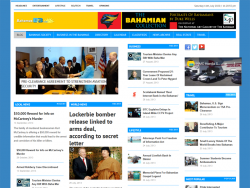Have you ever created a website and were proud of the end result? Have you then decided to apply for awards, like the Bahamas Web Awards, but unfortunately with a disappointing outcome? If so, you have probably wondered about what it was that kept your creation from earning the desired accolades. You probably started to ask yourself what separates your site from those that sport several top rated awards. At one time or another we all walked in those shoes.
So, why is that? Why are some websites with seemingly similar design and content more successful than others? What IS it that makes an award winning website?
Tough question!
You can randomly pick 10 people from the award community, broach the subject and you will most likely receive 10 different answers. As the owner of a successful award program, I too have been asked this very same question on numerous occasions and the answer has never been easy. Since award programs are created by individuals with their own set of likes and dislikes, it is hard to generalize. What one person might regard as Gold or Platinum Award material another wouldn’t even consider for their Merit Award.
So, what’s the advice? What guidelines shall we follow if we aim to pocket as many high level awards as possible? Isn’t there some kind of golden rule that if adhered to can increase the chances of our website receiving the recognition we think it deserves?
Perhaps.
In the last few years I gained some experience in both website design and evaluation, and I will share the benefit of same here. In my opinion there are a few key elements that if given the required attention make all the difference when it comes to receiving awards …
The Message
No matter what is your reason for making a web site ラ be it establishing a business presence online, providing research information on your favorite animal or displaying your cherished photos from your last vacation ラ it is mainly your message that will determine the value of your content.
In today’s fast paced world information is key. Even if you just want to display your watercolor artwork, added information about the colors and techniques you used, your motivation for that particular subject, etc., makes all the difference. Make it interesting even for those who never before held a paintbrush or visited an art gallery.
Let’s imagine we are building a site about Ancient Egypt. First we decide on what we want to display. Will it be Egyptian art, translations of ancient hieroglyphs or the legend of the mother-goddess Isis and her brother and husband Osiris? Whatever we decide, we will research the subject in depth and provide the information in an interesting and entertaining way so even those who have never had any previous interest in the topic should be fascinated.
Let’s say, we decided to discuss the facts and legends surrounding the Great Pyramid in Giza. First we need to gather as much information about the subject as possible, including illustrations and/or photographs, and we have to organize it all into different sections. Then we need a “summary” or “welcome” page that will advise our visitors what they will find on our website, how to navigate, etc.
Next we need a section devoted completely to the information we compiled. This section should be broken down in turn into several subsections, just like a textbook. Lastly we need a credits and resources section where we can provide information about the origins of our research material and possible links to other websites with similar or other relevant and useful content.
The Look
So, how would we decide what kind of look would work best with our Egyptian site? Before we even think about graphics we need to break the content down into separate pages. We should aim to keep these relatively short, as pages that scroll endlessly are widely considered unprofessional. If our information cannot fit on a page of an acceptable length we should break it down further and create appropriate sub navigation.
Now it’s time to decide on a layout. We know how many pages our site has and we know how the navigation will work because we drew up a diagram, so all we have to do is decide on the trimmings.
First impressions do count ラ no matter what some people say to the contrary ラ and it is just as important with websites. No matter what design you choose to use if it relates to or complements your content you will be more likely to achieve the best results.
What type of design is the best? It really does not matter that much if you use vector graphics, intricate Photo Shop creations or just a set of cleverly arranged colored tables to surround your content with. The key here is to be unique but pleasant, innovative but user-friendly. Be original with your layout but do not go overboard with unnecessary eye candies. The design should enhance but not overpower the content.
The most disappointing websites I have ever visited were those that had great content, but were full of animated graphics and Java applets and a different midi on each page that took forever to load. That simple rule applies here too: Sometimes less is more!
The Ease
Now that we have our content organized into neatly designed and visually enhanced pages we can turn our attention towards the accessibility. So, providing a simple and easy way to get around our site will be our next step.
The navigation should be self-evident and have a seamless flow to it. Nobody likes to race around the screen with the cursor to find that hidden “next” button. Make it easy to get around your site. Even if you have the most awesome rollover navigation buttons on the top of every page a simple text navigation bar on the bottom will show everyone that you just went that extra step further.
Define the dimensions of your graphics with
If you use frames don’t forget to insert
What Else?
There are a few other items that can contribute to the success of a website when they are submitted for awards. Let’s go through them one by one.
1. ᅠᅠCoding
Keep it clean and error free. Make sure you leave no loose ends and close all your tags.
2. ᅠᅠScripts
Don’t go overboard with them and make sure they won’t crash your visitor’s browser.
3. ᅠᅠPlug-ins
Don’t use elements that require your visitors to download a plug-in before they can view your site. Some of us are very reluctant to do so because of past experiences with viruses.
4. ᅠᅠContent
Keep it kids safe. If you have sensitive material on your website, like artwork that contains some nudity, post a warning on the previous page advising parents of same.
5. ᅠᅠSpelling
Make sure that your content is proofread. Incorrect spelling and grammar can keep an otherwise content rich site from being taken seriously.
6. ᅠᅠLinks
Check your links regularly and make sure that the websites you link to are also kids safe. While you cannot be made responsible for their content, by linking to them you endorse them.
7. ᅠᅠGraphics
Make sure there are no broken graphics on your pages and try to optimize them as much as possible ラ without overdoing it ラ to reduce loading time.
8. ᅠᅠPrivacy
If your website collects personal information for any reason you should post a privacy notice stating what exactly that information is going to be used for. If your site is US-based, there should also be a COPPA statement included.
9. ᅠᅠPop-ups
About 99% of the evaluators hate them. Period. It is one thing if your site is on a free server that forces advertising pop-ups on your pages, but it is an entirely different situation if the first thing that greets a visitor when opening your site is a Java popup asking for their name. Don’t do it!
10. ᅠᅠSounds
If you use background music on your pages make sure that there is a way to disable it. Many of us surf the web with our own music or the television turned on and a possible combination of a Ricky Martin midi and Beethoven’s Appassionata does not sound very appealing, does it? ᅠ
In Closing
If you have built a website and want to know if it is award winning material the best way to find it out is to submit it to award programs. If you don’t get the desired results and don’t know why, then show your site to your friends and family. Ask them for their honest opinion and listen to the constructive criticism. They might tell you something that you overlooked.
Following the suggestions outlined above will not guarantee you instant success, but hopefully it will point you in the right direction. Remember, award programs are run by people from all walks of life and they have wide ranging tastes and preferences. What one considers the cream of the crop another just frowns upon. It is very hard to please everyone, but it can be done!
About the Author
Monika Carter is the creative force behind the TMC Exceptional Design Awards. She is also an executive member of CEM/CEMA (Website Evaluators Code of Ethics) and is currently holding the position of Disputes Panel Chair Person. Monika entered the computer world at age 18 when she enrolled in an IT and Business College in Vienna, Austria, and she has never looked back since. She has a highly creative mind and a wide range of interests and found the Internet an excellent outlet for her restless soul.



